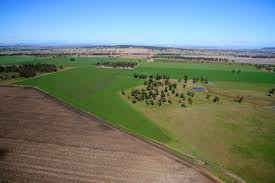STRONGER legislative frameworks and clear communication are needed if the true value of agriculture is to be protected, and farming and extractive industries are to successfully co-exist, according to a new report by 2016 Nuffield Scholar Angus Duddy.
The ability of agriculture and energy extraction to co-exist has been debated in Australia for many years, and Mr Duddy’s scholarship, which has been supported by the Grains Research and Development Corporation, brings a fresh perspective to the issue by looking at overseas communities where the two industries operate side by side.
Mr Duddy runs a cotton, grain and beef operation on the highly productive Liverpool Plains of northern New South Wales, where the development ambitions of two large coal mining companies have put the co-existence issue at the forefront of the local agenda for many years.
This personal experience motivated Mr Duddy’s Nuffield research into what it takes to achieve successful industry co-existence.
His research led him to the conclusion that much of the problem is caused by a communication breakdown between farmers, local communities and energy companies.
“The true value that is derived from land and water assets is neither well communicated by farming communities nor well understood by the energy companies. The resulting imbalance in the perceived value of assets means that, from the very outset, the parties are coming to the table from drastically different positions,” Mr Duddy said.
“It’s not surprising that mining and agricultural businesses value and prioritise different land characteristics. However, this value imbalance is not reflected in the legislative framework that guides mining development, making co-existence extremely difficult to achieve.”
Development rights program
Mr Duddy’s Nuffield experience took him around Canada and the United States, where he researched communities endeavouring to achieve co-existence between agriculture and energy extraction operations.
The report highlights the case of the Fayette Alliance in Lexington, Kentucky, which serves as an example of a situation where the true ‘inherent’ value of agricultural land and industries has been clearly articulated and protected.
“The Fayette Alliance is quite astonishing,” he said.
“It started as a University of Kentucky initiative to measure the influence of the Thoroughbred industry on the local economy. The report found that traditional approaches to valuing an industry looked only at the production output. When the framework was expanded to capture the value of input industries, processing, transport, communications and retail in the district, the true value of the industry was realised.
“The Fayette Alliance now works to sustainably grow the city of Lexington while promoting the security of the stud industry and the land required for it to thrive. The landscape of the area is a fundamental component, and the value that the scenic and productive features of the land contribute to the brand and reputation of the Kentucky Thoroughbred industry is recognised and protected.”
The Fayette Alliance has established a ‘Purchase of Development Rights Program’, whereby landholders can create agricultural easements across their land, forgoing their right to development, but enshrining the protection of the landscape that is so pivotal to the industry.
“The success of the program shows how well the real value of the Thoroughbred breeding industry has been communicated to the local community. They value the industry so much, that they are willing to forego their own personal rights to development to preserve the land on which the industry relies,” Mr Duddy said.
Land rehabilitation
The report also explores post-extraction rehabilitation in agricultural areas, showcasing an example in Jacksonville, Indiana, which produced good farming results.
According to the report, the key to successful land management and co-existence in the post-mining phase is clear communication and transparent guidelines around what is expected and required from the energy company, as well as significant financial penalties if these requirements are not met.
 “There are certain overseas examples where positive results for all stakeholders have been achieved through meaningful community consultation, transparent and accountable operations, and clear expectations during development and post-development phases,” Mr Duddy said.
“There are certain overseas examples where positive results for all stakeholders have been achieved through meaningful community consultation, transparent and accountable operations, and clear expectations during development and post-development phases,” Mr Duddy said.
“It’s more realistic to think that equitable outcomes will be achieved when government, agriculture, mining and science work closely and transparently. If the true, inherent value of agricultural land is not clearly articulated, it is difficult for this value to be reflected in planning, development and regulatory decisions.
“Once it has been truly quantified, the value of agricultural land and the farming industries it supports are more readily protected,” he said.
Source: Nuffield Australia
Grain Central: Get our free daily cropping news straight to your inbox – Click here




HAVE YOUR SAY